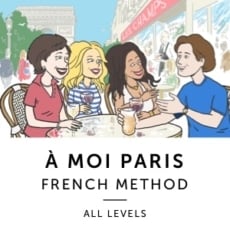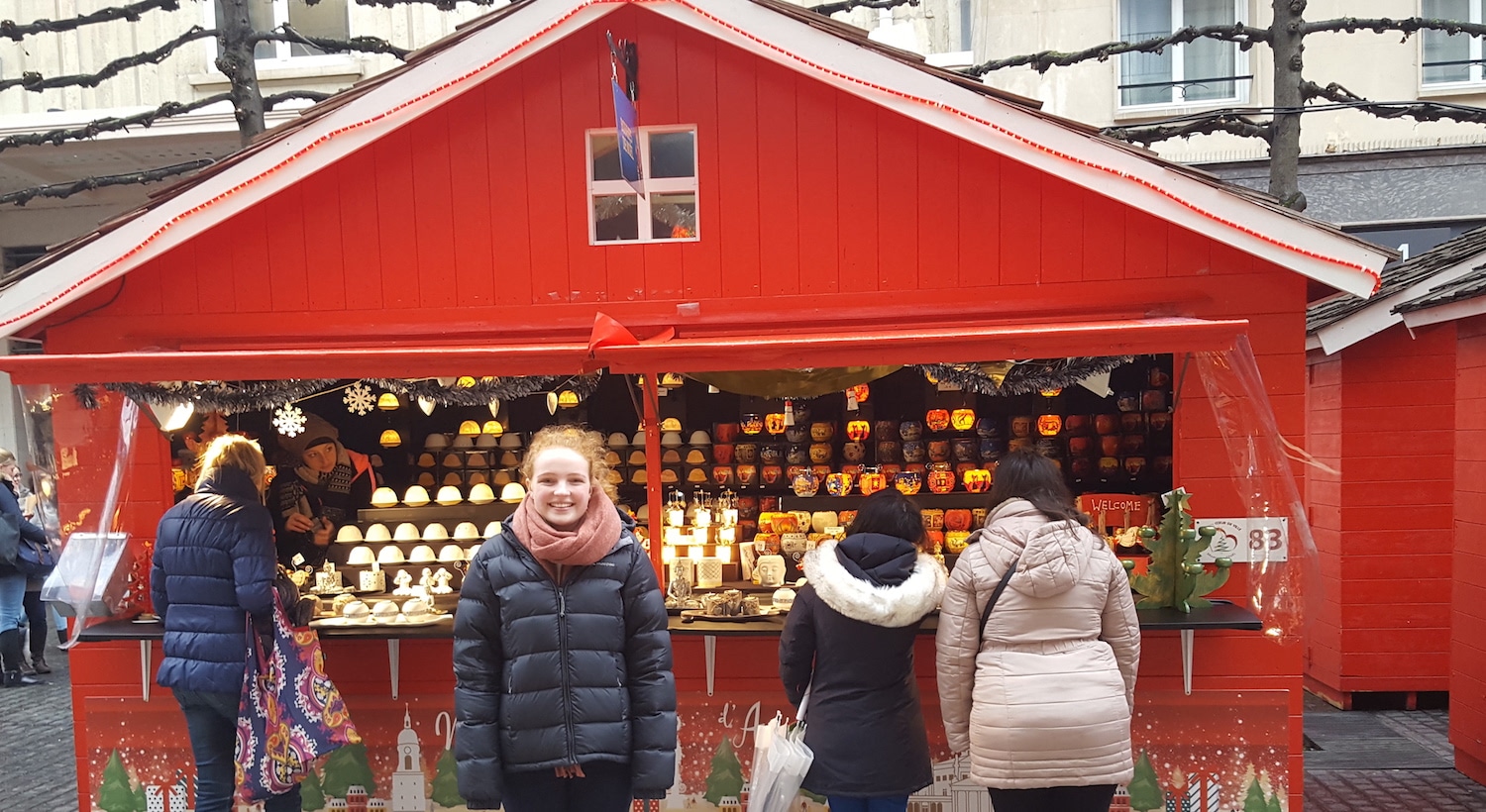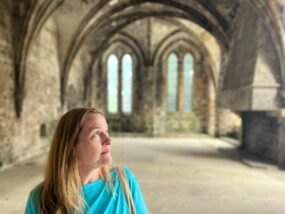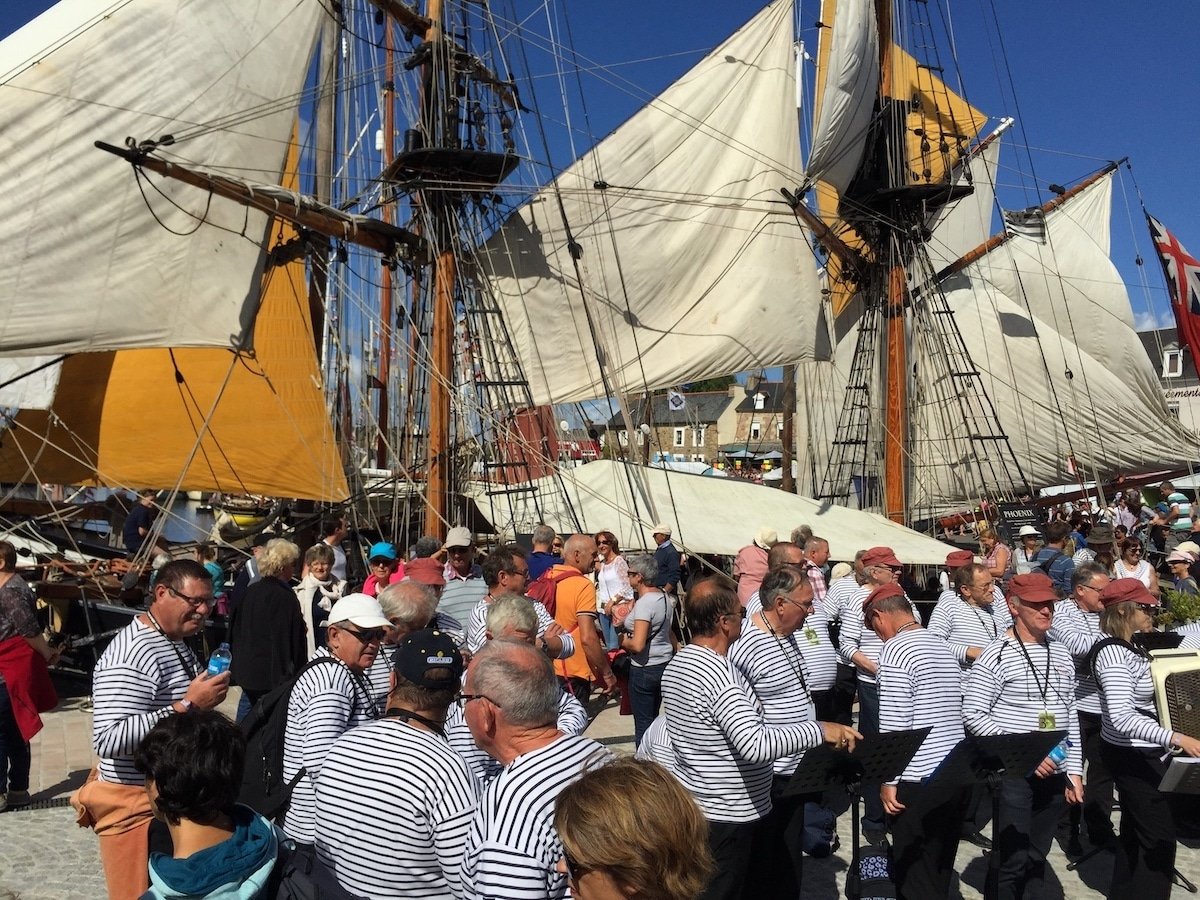Use the floating blue icon in the bottom right to hide/reveal the English translations below or just click here.
Mon étudiant Michael est revenu chez nous pour un troisième séjour d’immersion en français, et je commence à bien connaître ses intérêts. Alors qu’est-ce qui pourrait lui faire plaisir pendant nos leçons cette fois, je me demande ?
My student Michael has come back for a third French immersion homestay, and I’m getting to know his interests. So what could make him happy during our lessons this time, I wonder?
1 – What were the Terre-Neuvas?
Tiens, ça y est, j’ai une idée ! Michael aime la mer, il a un voilier. Il aime l’histoire et il aime apprendre la culture des pays qu’il visite. Je réfléchis… Puis c’est au moment où il me dit qu’il a visité Paimpol sur la côte nord de la Bretagne (là où habite Camille !), que je me prépare à lui parler des ‘Terre-neuvas’ (nom portugais qu’on utilise aussi en français pour désigner cette pêche) et des ‘Islandais’. Ce sont les noms donnés dans le passé aux hommes qui allaient pêcher la morue au large de la Terre-Neuve, et plus tard au large de l’Islande, du seizième jusqu’au vingtième siècle.
Hey, I’ve got it, I have an idea! Michael loves the sea, he has a sailboat. He loves history and likes to learn the culture of the countries he visits. I think hard … It’s when he tells me that he has visited Paimpol on the north coast of Brittany (where Camille lives!), that I decide to prepare information to talk to him about the ‘Terre-neuvas’ (Portuguese name also used in French to talk about that fishing) and Islandais. These are the names given in the past to men fishing for cod off Newfoundland, and later off Iceland, from the sixteenth to the twentieth century.
- « Ah bon », me dit Michael, « je pensais qu’ils allaient plutôt en Nouvelle Ecosse ? »
- « Oui, c’est vrai qu’ils y allaient aussi », je réponds, « mais je pense que là, c’était surtout les pêcheurs anglais/britanniques. »
“Ye
- “Oh,” said Michael, “I thought rather that they used to go to Nova Scotia? “
- s, it’s true that they went there too,” I answer, “but I think that was mostly English / British fishermen.”

A new approach to learning both traditional and modern French logically structured for English speakers.
2 – French Fishermen Fishing Cod in Iceland
Je poursuis… « Saint Malo, pas très loin de chez nous, était très, très important dans la pêche à la morue. Les capitaines des goélettes – des bateaux à voile avec deux ou trois mâts – recrutaient leur équipage et s’approvisionnaient pendant janvier et février, puis les bateaux partaient au printemps pour passer entre 6 et 8 mois dans l’Atlantique du nord-ouest. Parmi les vingt ou plus membres de l’équipage, il y avait un ou deux mousses – des garçons de 14 à 16 ans. Les marins passaient la plupart de l’année en mer. On disait “qu’ils ne voyaient pas les feuilles des arbres.”
I continue… “Saint Malo, not far from where we live, was very, very important for cod fishing. The captains of schooners – sailing boats with two or three masts – recruited their crew and stocked up during January and February, then the boats left in the spring to spend between 6 and 8 months in the northwest Atlantic. Of the twenty or more crew members, there were one or two ‘mousses’ – cabin boys from 14 to 16 years old. The sailors spent most of the year at sea. It is said that ‘they never saw leaves on the trees’. “
- « Tous les ports dans le nord de la Bretagne étaient concernés, n’est-ce pas ? demande Michael. Dahouët, Binic, St Quay, aussi bien que Paimpol ? »
- « Oui, c’est vrai, et beaucoup des ports près d’ici ont leur ‘quai des Terre-neuvas’. J’ai regardé un documentaire hier soir sur You Tube qui faisait référence à Fécamp en Normandie aussi. Même si la Bretagne était très impliquée dans la pêche à la morue, ce n’était pas la seule région. Le Grand Banc au large de Terre-Neuve était très riche en poissons. Des milliers de bateaux de pêche partaient de Bordeaux, du pays basque, du Portugal, d’Espagne, d’Angleterre, d’Irlande… de toute la côte Atlantique européenne, sans mentionner le continent américain. Au cours du dix-neuvième siècle, cette pêche a atteint une échelle industrielle. »
- “All the ports in the north of Brittany were concerned, weren’t they?” asks Michael. “Dahouet, Binic, St Quay, as well as Paimpol? “
- “Yes, that’s right, and many of the ports around here have their ‘Newfoundland quay’. I watched a documentary last night on You Tube that referred to Fécamp in Normandy too. Although Brittany was very involved in the cod fishery, it was not the only region. The Great Banks off Newfoundland were very rich in fish. Thousands of fishing boats left Bordeaux, the Basque country, Portugal, Spain, England, Ireland … all the European Atlantic coast, without mentioning the American continent. During the nineteenth century the fishing reached an industrial scale. “

3 – Les Pêcheurs des “Terre-Neuvas” en France
Michael s’intéresse beaucoup à notre conversation. Il puise dans son expérience de navigateur pour poser sa prochaine question: « Est-ce que le film que vous avez regardé a expliqué la route que prenaient les bateaux qui allaient en Terre Neuve ? J’aimerais savoir si les bateaux y allaient directement, ou s’ils utilisaient les courants océaniques, les courants porteurs qui circulent dans le sens des aiguilles d’une montre.»
Michael is very interested in our conversation. He draws on his experience as a sailor to ask his next question: “Did the film you watched explain the route taken by the boats that went to Newfoundland? I would like to know if the boats went there directly, or if they used to use the ocean currents, which flow in a clockwise motion.”
« Alors là, je ne sais pas, on va devoir regarder le film encore pour voir s’ils en parlent. Il y a beaucoup de documentaires sur You Tube à ce sujet. Nous allons pouvoir faire des recherches ! Moi, ce que je sais des Terre-neuvas concerne surtout la Bretagne. J’ai un ami, mon ancien cavalier de danse bretonne qui s’y intéresse beaucoup. Il a recueilli beaucoup de documents et de témoignages de gens dans les villages près d’ici, et il y a quelques années il a préparé une exposition sur les Terre-neuvas dans notre coin, et sur l’influence de cette économie dans la vie locale de l’époque. C’est à ce moment-là que j’ai commencé à m’y intéresser.»
“Ooh, I don’t know, we’ll have to watch the film again to see if they talk about that. There are a lot of documentaries on You Tube on the subject. We can do some research! What I know about the Terre-neuvas mostly concerns Brittany. I have a friend, my former Breton dance partner who is very interested in the subject. He collected a lot of documents and testimonies from people in villages near here, and a few years ago he prepared an exhibition on the Terre-neuvas in our area, and on the influence of the long-distance fishing economy on local life of the time.. That’s when I started to get interested in it.”
4 – The Tough Life of the French Cod Fishermen
En Bretagne, la vie des paysans à la campagne était difficile. Les familles nombreuses étaient souvent très pauvres, et le travail de pêcheur était mieux payé que le travail à la ferme, si la pêche était bonne. Des fois on gagnait trois ou quatre fois plus que si on restait travailler sur la terre. Mais c’était un travail dangereux, plein de risques, dans des conditions éprouvantes.
In Brittany, the life of country dwellers was difficult. Large families were often very poor, and fishing work was better paid than farm work, if the catch was good. Sometimes they earned three or four times more than if they stayed working the land. But it was dangerous work, full of risks, and in trying conditions.
Certains bateaux s’amarraient régulièrement sur la côte de Terre-Neuve, où ils avaient des sécheries de poissons, ou à Saint Pierre et Miquelon, un archipel français juste au sud de Terre-Neuve. Mais d’autres passaient tout leur temps sur le Grand Banc et des membres de l’équipage salaient le poisson dans la cale du bateau. Imaginez ça – des mois entiers sans toucher la terre ferme, et ceci quelquefois pendant des semaines entières dans un brouillard épais ou une mer très agitée. Puis les risques posés par les icebergs, ou par les paquebots transatlantiques qui arrivaient à toute vitesse, même par un temps de brouillard purée de pois, et qui risquaient de couper les goélettes en deux – n’en parlons pas !
Some boats moored regularly on the Newfoundland coast, where they had fish drying racks, or in Saint Pierre and Miquelon, a French archipelago just south of Newfoundland. But others spent all their time on the Great Banks, and crew members salted the fish in the hold of the boat. Imagine that – whole months without touching terra firma, sometimes for weeks at a time in thick fog or rough sea. Not to mention the risks posed by icebergs, or transatlantic liners that came by at full speed, even during a pea-souper fog, and which could break the schooners in two!
Entre la pêche le matin, puis l’après-midi, le tranchage, nettoyage et salage des morues capturées, et finalement la préparation des lignes le soir, beaucoup de témoignages parlent de 18 heures de travail par jour – un travail d’arrache-pied. Quelquefois on pêchait à la ligne directement par-dessus bord, mais on pouvait augmenter la production si les pêcheurs quittaient le bateau principal à deux dans de petites barques à rames appelées ‘doris’.
Between fishing in the morning, then slicing, cleaning and salting the captured cod in the afternoon, and finally preparing the fishing lines in the evening, many reports speak of 18 hours of work a day – very hard work. Sometimes they fished directly over the side of the schooner, but they could increase production if the fishermen left the main boat in pairs in small rowboats called ‘dories’.
Avant de partir dans leur doris, les deux pêcheurs devaient préparer leurs lignes : des milliers d’hameçons sur vingt-quatre lignes, chacune de 130mètres de long, par exemple. Il fallait cinq heures chaque soir et nuit (s’il faisait assez clair !) pour préparer ces lignes, selon l’ancien Terre-neuvas et l’historien interviewés ici https://www.youtube.com/watch?v=b_qu3rix2IE
Before leaving for their dories, the two fishermen had to prepare their lines: thousands of hooks on twenty-four lines, each 130 meters long, for example. It took five hours each night (if there was enough light!) to prepare these lines, according to the former Terre-neuvas and the historian interviewed here https://www.youtube.com/watch?v=b_qu3rix2IE
Si le brouillard descendait pendant qu’ils étaient dans le doris, une corne de brume actionnée sur la goélette les aidait à revenir aussi vite que possible… mais quelquefois les doris se perdaient à tout jamais. On perdait souvent des pêcheurs par-dessus bord de la goélette, ou le bateau lui-même coulait par temps de tempête ou après une collision. Beaucoup de marins ont perdu la vie sur le Grand Banc ou au large d’Islande ou de Groenland, comme en témoigne le nombre de cimetières côtiers et de monuments aux ‘disparus en mer’. http://www.marinsdislande.fr/
If the fog came down while they were in the dory, a fog horn activated on the schooner helped them to get back as fast as possible … but sometimes the dories were lost forever. Fishermen were often lost overboard the schooner, or the schooner itself sank in stormy weather or after a collision. Many sailors lost their lives on the Great Banks or off Iceland or Greenland, as shown by the number of coastal cemeteries and monuments to those ‘disappeared at sea’.
Pourtant, et malgré la concurrence entre les milliers de bateaux, la pêche était souvent très bonne. Dans le petit film sur YouTube cité ci-dessus, l’ancien Terre-neuvas montre son ‘carnet de morue’ de 1938 où on écrivait le nombre de poissons pêchés par jour dans son doris : 400 ou plus certains jours, beaucoup moins d’autres jours, avec un total de 2700 morues en juillet, et 16 130 pour la campagne entière. Les morues de taille moyenne pesaient entre deux et quatre kilos, mais dans le passé on trouvait aussi de très gros individus allant jusqu’à 100 kilos.
However, and despite the competition between thousands of boats, the fishing was often very good. In the little movie on YouTube mentioned above, the former Terre-neuvas shows his 1938 “cod diary” where the number of fish caught per day in his dory was noted: 400 or more on some days, much less other days, with a total of 2700 cod in July, and 16 130 for the entire campaign. Medium-sized cod weighed between two and four kilograms, but in the past there were also very large individuals up to 100 kilos.
5- The End of the Terre-Neuvas Fishing
Hélas, les années de bonne pêche ne pouvaient pas durer toujours. L’ère de la mécanisation a mis fin à l’utilisation des goélettes. Le dernier voilier terre-neuvas a quitté Saint Malo en 1951. Des chalutiers, puis des bateaux-usines prenaient leur place. Ces derniers pouvaient pêcher beaucoup plus de morues en moins de temps, et rester sur place plus longtemps. Inévitablement, la surpêche a suivi, les stocks de morues se sont effondrés, et les Etats Unis et le Canada ont limité l’accès aux eaux de l’Atlantique du nord pendant les années 1970. Puis le Canada a imposé un moratoire total sur la pêche à la morue au Grand Banc en 1992 pour essayer de laisser aux poissons le temps de reconstituer leurs stocks. La fin d’une époque.
Alas, the years of good fish catches could not last forever. The era of mechanization ended the use of schooners. The last sailboat to Newfoundland left Saint Malo in 1951. Trawlers, then factory boats took their place. They could fish a lot more cod in less time, and stay there longer. Inevitably, overfishing followed, cod stocks collapsed, and the United States and Canada limited access to North Atlantic waters during the 1970s. Then Canada imposed a total moratorium on cod fishing on the Great Banks in 1992 to try to give the fish time to replenish their stocks. The end of an era.
Et ainsi s’achève une activité qui a fait pendant longtemps une partie importante de l’économie locale, du patrimoine historique, et qui a marqué des générations de familles en Bretagne et ailleurs. Il nous reste les musées des terre-neuvas, les expositions, les livres, les documentaires, les témoignages filmés des derniers Terre-neuvas… et beaucoup de chants de marins.
And so ends an activity that was for a long time an important part of the local economy, of the historical heritage, and which marked generations of families in Brittany and elsewhere. We still have the museums dedicated to the Terre-neuvas, the exhibitions, the books, the documentaries, the filmed testimonies of the last Terre-neuvas … and many sea shanties.
Le musée des Terre-neuvas à Saint Malo https://www.mpterreneuvas.fr/le-musee
Si ce sujet vous intéresse, vous aimerez l’article de Camille sur le Festival du Chant de Marin à Paimpol









Comments